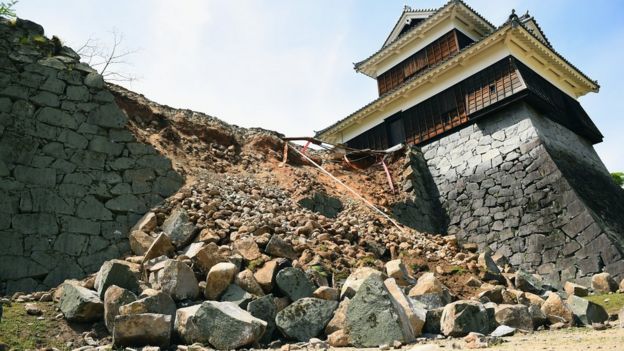
Rescuers are in a "race against time" to find survivors of a powerful earthquake amid forecasts of heavy rain and cold overnight, Japan's Prime Minister Shinzo Abe has warned.
Mr Abe admitted rescue operations throughout the night in the Kyushu region "will be extremely difficult".
At least 32 people have been killed and hundreds injured, with thousands forced to seek refuge outdoors and dozens still feared trapped beneath rubble.
A quake on Thursday killed nine people.
It's raining, it's cold and there's no-one here: Mashiki is deserted.
It's not safe to stay. Walk round for 30 seconds and you'll see why - house after house has crumpled or shifted off its foundations. They are mostly single-storey or small apartment blocks. One has a crushed camper van partially holding it up. Another has a balcony that's been forced forward and is now teetering dangerously over the road.
A handful of cars passed us, slowing to swerve around the roof tiles that lie shattered on the road after the front of one small house fell forward, like something out of a Charlie Chaplin movie. Inside you can see furniture, exposed by the earthquake. There's a blue framed walking frame getting wet in the rain.
Both quakes were shallow and struck close to the city of Kumamoto, causing huge damage to roads, bridges, tunnels, homes and buildings.
Big landslides have cut off remote mountain villages.
Some 100,000 households remain without power while around 400,000 homes are without water.
Mr Abe told an emergency meeting on Saturday evening that the rain and winds had begun and "are expected to get stronger".
Saturday's magnitude-7.3 quake struck at 01:25 (15:25 GMT on Friday) at a depth of 10km (six miles) closet to the city of Kumamoto, which had already been hit by a magnitude-6.4 quake on Thursday night.
Nearly 2,000 people received hospital treatment. About 190 of the injured are in a serious condition, the government said.
There are many reports of people trapped inside buildings. Chief Cabinet Secretary Yoshihide Suga said rescue workers were aware of "multiple locations where people have been buried alive".
One village had to be evacuated after a dam collapsed as a result of the quake.
 AFP
AFP EPA
EPA AFP
AFP
Some 20,000 troops were deployed to help police and firefighters in the rescue effort.
They have also been helping some of the 92,000 people who have been forced to evacuate their homes.
Thousands of people spent the first night on the streets and in parks - where they were huddled under blankets looking dazed and afraid.
They were urged to seek shelter with the approaching storm. Tents were being set up and tarpaulins handed out, along with food and water.
 AFP PHOTO/DEFENCE MINISTRY/JIJI PRESS
AFP PHOTO/DEFENCE MINISTRY/JIJI PRESS Getty Images
Getty Images AFP
AFP Getty Images
Getty Images
Chris Tempest was one of many to have left his flat for an evacuation centre in Kumamoto.
"We returned to our apartment but there is a huge mess. We are without running water, electricity and gas," he told the BBC.
"The mayor of the prefecture has told people to put out bucket and containers to catch rainwater to help."
Japan's nuclear authority said the Sendai nuclear plant was not damaged.
A small eruption occurred at Mt Aso following the tremor, media reports say.

Thursday's quake caused shaking at some places as intense as the huge earthquake that hit the country in 2011, Japan's seismology office said.
The 2011 quake sparked a huge tsunami and nuclear meltdown at the Fukushima power plant.
Most of those who died in Thursday's quake were in the town of Mashiki where an apartment building collapsed and many houses were damaged.
Analysis: Jonathan Amos, BBC science correspondent
Japan is one of the most seismically active areas on Earth, accounting for about 20% of global quakes of magnitude 6.0 or greater. Seismometers are recording some kind of event every five minutes, on average.
It is through bitter experience that Japan has learnt the strategies to mitigate damage, injury and death. Not only does it implement some the best building construction practices but it has also established an early warning network.
This system relies on the lightning analysis of the developing quake, establishing its location and strength. Alerts are then broadcast that can give people more distant from the epicentre vital seconds' notice.
Just 10 seconds is more than sufficient to drop and get under a sturdy table or open the doors of a fire station.
The prospect of buildings already damaged in Thursday's quake toppling over in this latest tremor will be a concern.
Are you in south-west Japan? Have you, or has someone you know, been affected by the earthquake? Email haveyoursay@bbc.co.uk with your experiences.
Please include a contact number if you are willing to speak to a BBC journalist. You can also contact us in the following ways:
0 Response to "Japan earthquake: Rescuers in 'race against time' as storm hits"
Post a Comment